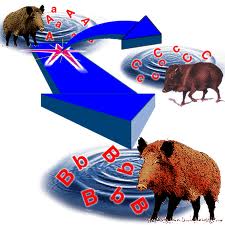Species: Latin word meaning “kind”
Speciation: The origin of new species
Macroevolution: The evolutionary changes above the species level eg. The appearance of feathers during the evolution of birds from one set of dinosaurs
Anagenesis – one species over time becomes another species
Cladogenesis– one species, over time, splits and becomes two species
Morphogensis– look at fossils to figure out how species evolved
Biological species concept: Defines a species as a population or a group of populations whose members have the potential to interbreed in nature and produce viable, fertile offspring with members of other populations
Reproductive isolation: the existence of biological factors that impede members of two species from mating
Prezygotic barriers: impede mating between species or hinder fertilization of ova if members of different species attempt to mate
Postzygotic barriers: often prevent the hybrid zygote from developing into a viable, fertile adult
Exploring reproductive Barriers:
Barriers that impede mating or hinder fertilization:
Habitat isolation: two species that occupy the same habitat may encounter each other rarely
Temporal isolation: species that breed during different times, seasons or years
Behavioral isolation: courtship rituals unique to certain species act as effective, reproductive barriers
Mechanical isolation: morphologic differences can prevent successful mating
Gametic isolation: sperm of one species may not be able to fertilize egg of another species
Barriers that prevent hybrid zygote from developing:
Reduced hybrid viability: genes of different parent species may interact and impair the hybrids development
Reduced hybrid fertility: hybrids are sterile
Hybrid breakdown: some first generation hybrids are fertile but when they mate with one another or a parent species, offspring of the next generation are sterile.
Other definition of species:
- Morphological species concept: characterizes species by body shape, size, and other structural features
- Paleontological species concept: focuses on morphologically discrete species known only from the fossil record
- Ecological species concept: views species in terms of their ecological niche
- Phylogenic species concept: defines species as a set of organisms with a unique genetic history.
Allopatric speciation (geographical speciation): when a population gets split and new population evolve. This is due to:
- Geographic isolation
- Genetic divergence
- RIMS – reproductively isolated
Sympatric speciation (instant speciation)
- Auto polyploidy – cell undergoes mitosis, but sister chromosomes do not split (mitotic error), twice the number of chromosomes. Then meiosis occurs, and the gametes come together creating a tetraploid zygote.
- Allopolyploidy – 2 cells undergo meiosis (meiotic error) = unreduced gametes. These two cells come together to form a hybrid. This undergoes meiosis. Another meiotic error occurs = unreduced gametes. These two gametes come together for a new cell.
Adaptive radiation: the evolution of many diversely adapted species from a common ancestor upon introduction to various new environmental opportunities and challenges
Punctuated equilibrium: when new species appear suddenly, persist essentially unchanged and then disappear
Heterochrony: evolutionary change in the rate or timing of developmental events
Allometric growth: different growth rates for different parts of the body determine body proportions
Paedomorphosis: adults retain body structures that were juvenile in ancestral organisms


great thanks